Here or Roundabout: Local scenes by Allan P. Tankard
Exhibition Information
These watercolour paintings show locations around the University of Liverpool campus in the post-war years. They are all the work of Allan Peel Tankard (1897 – 1964), a teacher at Liverpool College of Art. Many of the paintings were commissioned to illustrate a book celebrating the University’s Golden Jubilee in 1953.
Tankard’s ability to depict local buildings in sharp detail became known through an earlier project called Recording Merseyside, organised by Liverpool Corporation in 1945. It culminated in a series of exhibitions at Bluecoat Chambers alongside other artists. But it was Tankard’s paintings that stood out.
In 1964 the Liverpool Daily Post said of Tankard that “in the last twenty-five years he has immortalised the changing face of Liverpool”.
Tankard’s ability to depict local buildings in sharp detail became known through an earlier project called Recording Merseyside, organised by Liverpool Corporation in 1945. It culminated in a series of exhibitions at Bluecoat Chambers alongside other artists. But it was Tankard’s paintings that stood out.
In 1964 the Liverpool Daily Post said of Tankard that “in the last twenty-five years he has immortalised the changing face of Liverpool”.
With thanks to Martin Strauss for his historical research for this project.
If you would like to learn more about the history of the Victoria Building, why not join Martin or another of our knowledgeable volunteers on a free guided tour on Tuesdays and Thursdays at 12.30pm. Ask at the Welcome Desk for details.
If you would like to learn more about the history of the Victoria Building, why not join Martin or another of our knowledgeable volunteers on a free guided tour on Tuesdays and Thursdays at 12.30pm. Ask at the Welcome Desk for details.
'Here or Roundabout: Local scenes by Allan P. Tankard' exhibition, Gallery 4, VG&M, 2020 - Spherical Image - RICOH THETA
You can zoom in and out of this 360 video by tapping on the + and - icons and you can move the camera around to see how the exhibition looks at the VG&M. Click on the Theta symbol in the bottom left corner to choose how you view this 360 video (straight mode, mirror ball, flay, little planet etc).
Artwork
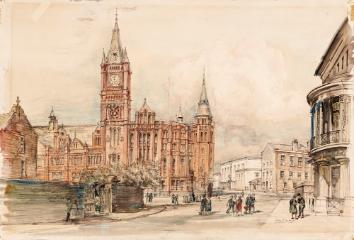
Sketch of the Victoria Building from the Guild of Students, 1946
(watercolour and pencil)
The artist faces the Victoria Building from Mount Pleasant. To the left is a curved wall with a gate, leading to what had been part of an enormous workhouse complex which served the basic needs of the city’s poor. In 1946 the University of Liverpool leased the surviving buildings to house its Botany, Metallurgy and Civil Engineering Departments.
To the right is the decorative Reilly Building which opened in 1911 and now houses the Guild of Students. It is named after its architect, Charles Reilly, who was Professor of Architecture at the University.
FA. 3177 Gift of Mrs Glenys Whitehead in 1999
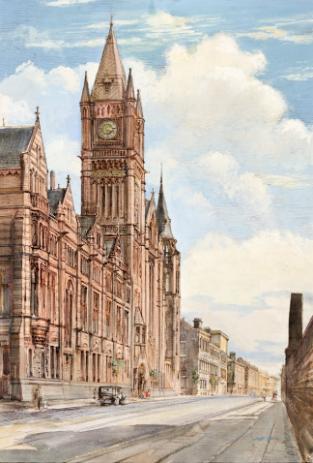
Victoria Clock Tower and Brownlow Hill, 1950
(watercolour, gouache and pencil)
The Victoria Building was the first purpose-built construction for what is now the University of Liverpool. It housed teaching spaces, offices, student common rooms and the main library. It opened in 1892 and the striking red terracotta cladding gave rise to the term ‘red brick university’. Named after Queen Victoria, the building’s tower bears an inscription celebrating her Golden Jubilee of 1887.
The building’s architect was Liverpool-born Alfred Waterhouse who favoured an opulent Gothic style. His other well-known buildings include the Natural History Museum in Kensington, Manchester Town Hall and Manchester University and Museum.
FA. 306 Purchased c. 1950.
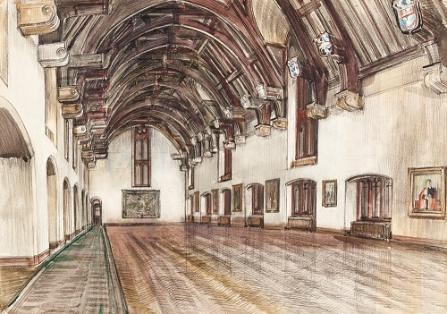
Tate Hall, 1952
(watercolour and pencil)
Tate Hall on the second floor of this building was constructed as the University’s main library. It is named after Sir Henry Tate, sugar merchant and philanthropist, who gave £20,000 towards it.
When the Harold Cohen Library opened across the road in 1938, all books were removed from Tate Hall and its mezzanine floor taken out. Thick beams had crossed the ceiling but these were cut out, although in 1953 metal ties were put in to link the beam ends together again.
In Tankard’s day portraits of University luminaries lined the walls and an antique tapestry hung at the far end. The otherwise empty space was then used for celebratory functions or for sitting examinations.
FA. 404 Commissioned in 1952
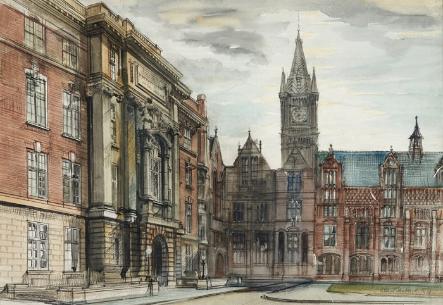
The Quadrangle, 1958
(watercolour, black chalk, wash and pencil)
Standing in The Quadrangle, the artist shows the rear facade of the Victoria Building with the Ashton Building on the left. The green space known as ‘The Quad’ was developed between 1887 and 1914 to echo the college quadrangles of Oxford and Cambridge Universities. Other buildings round the perimeter include the Walker Engineering building (1887), the Thompson Yates building (1895) and the George Holt building (1904).
The Quad was re-designed with seating and pleached beech trees in 2012 to commemorate the Queen’s Diamond Jubilee. There is an excellent view of it from the Tate Hall windows. It is a magnet for students and staff during warm, sunny lunchtimes.
FA. 1086 Gifted by the artist in 1958
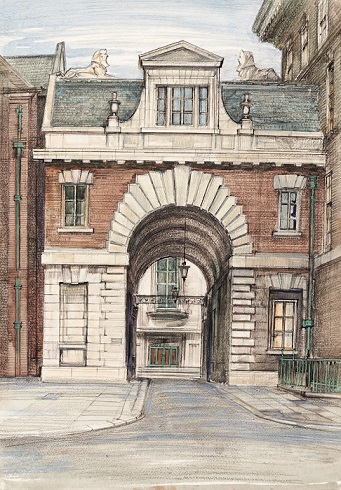
The New Arts Entrance, 1952
(watercolour, wash, ink and pencil)
This ornate archway leads from The Quadrangle on to Ashton Street to face the Harold Cohen library. It forms part of the Ashton Building.
Although hundreds of people walk through the archway every day, not many look up to see the pair of sphinxes perched on top. Mythical creatures with a human head and a lion’s body, they appear in several classical civilizations including ancient Egypt where they usually represent protection from evil. These sphinxes are by Scottish sculptor William Birnie Rhind.
FA. 309 Commissioned in 1952
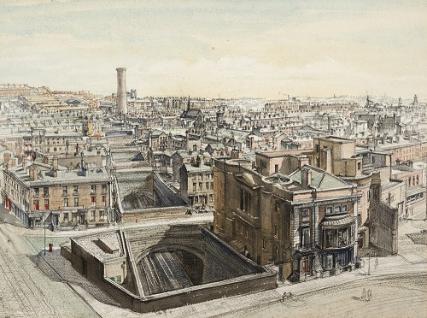
Student’s Union and Railway Cutting from the Victoria Building, 1952
(watercolour, pencil and charcoal)
The artist stood on the roof of this building, looking east, to capture this view. Dominating it is the submerged cutting for the rail-line carrying passengers from Lime Street to Edge Hill and beyond. The first two cuttings were covered over in the 1960s.
To the right stands the Guild of Students building dating from 1911. It is now named after Charles Reilly who designed it and was Professor of Architecture for 30 years. Its eclectic style contrasts with the Victoria Building’s gothic architecture which Reilly loathed.
For some reason, Tankard called this painting ‘Drapers’ after a shop to the left of the composition.
FA. 405 Commissioned in 1952
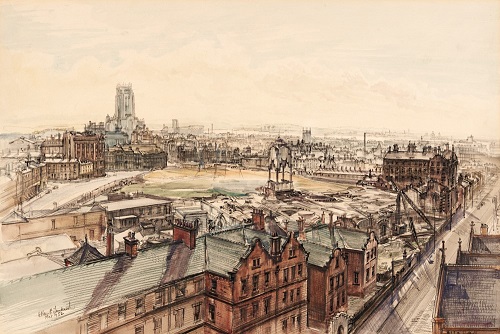
Metropolitan Cathedral Precinct, 1952
(watercolour, pencil and charcoal)
Looking west from the roof of this building, the artist captures early stages of the Metropolitan Cathedral development. Previously, it had been the 9-acre site of the West Derby Union Workhouse, most of which was demolished in 1928. The Catholic Diocese then bought the plot and engaged Sir Edward Lutyens to design a new Cathedral. Tankard shows the Crypt which was completed before plans changed several times. Today’s striking Modernist building by Sir Frederick Gibberd was finally completed in 1967.
In the foreground are some remaining Workhouse buildings occupied by the University of Liverpool since 1946. The University’s Foundation Building now stands on the site along with some busy food and retail outlets.
FA. 563 Commissioned in 1952
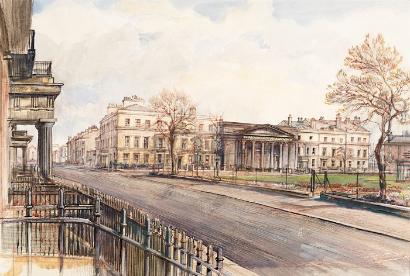
East Side of Abercromby Square, 1952
(watercolour, pencil and charcoal)
This elegant Georgian square sits at the heart of the University of Liverpool campus. It is named after General Sir Ralph Abercrombie who came to prominence during the Napoleonic Wars. The ground was originally marshland but was drained, allowing building to begin in 1816. Construction was largely completed by 1846 and mostly comprised of prestigious housing.
St Catherine’s Anglican Church dominates this view of the square. Designed by John Foster Jnr in the imposing Greek Revival style, it was consecrated in 1831. The church suffered extensive bomb damage during the war and was abandoned. It was eventually demolished in the 1960s along with the adjacent buildings. Senate House, with the Sydney Jones Library, now stands on the site.
FA. 308 Commissioned in 1952
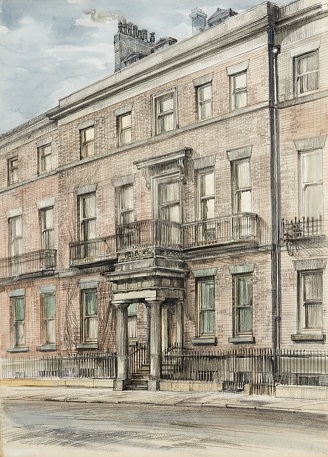
Staff House, 1952
(watercolour, pencil and charcoal)
Staff House stands at 4, Abercromby Square on the west side. It is part of a terrace of late-Georgian buildings dating from the 1820s, with an iron balcony over a distinctive Doric porch. This house, like others on the square, was originally occupied by the families of Liverpool’s wealthy merchants. By the end of the 1800s, as the University developed, houses on the square were increasingly occupied by academic staff. Number 4 was the home of Professor Alfred Dale, the Vice-Chancellor.
The University of Liverpool officially took over the premises in 1948 and Staff House expanded to incorporate neighbouring properties. Today, the block is home to several of the University of Liverpool teaching departments.
FA. 403 Commissioned in 1952
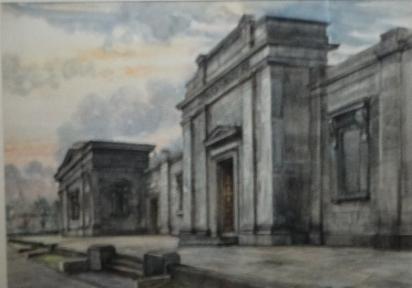
The Old School of Medicine, 1952
(watercolour, wash, charcoal and pencil)
This Neo-classical stone building dates from 1844 and was constructed to house the Medical School and its 25 students. It was built on Dover Street, in the grounds of the psychiatric hospital, or ‘lunatic asylum’ as it was commonly known. The left wing of the building was a later extension added in 1873, when the Medical School had about 80 students.
By the end of the war the School of Medicine needed to expand again. Plans began for a new building on Ashton Street and the move was made in 1957. The old building was mostly demolished except for a small section with the original lecture theatre. It is now part of the Veterinary Science Department.
FA. 307 Commissioned in 1952